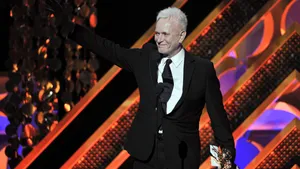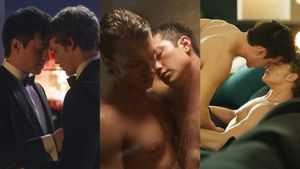
On the morning of December 22, 1986, Derek Jarman was diagnosed as HIV-positive. In addition to being a controversial filmmaker, author, set designer, gardener, and queer activist, Jarman was also an avid diarist. He wrote many things in his diary on the day of his diagnosis, among them this gem:
"We must fight the fears that threaten our garden, for make no mistake, ours is the garden of the poets of Will Shakespeare's sonnets, of Marlowe, Catullus, of Plato and Wilde, all those who have worked and suffered to keep it watered... Pull yourself together and put on the best of your masks to face the new day."
That quote perfectly illustrates Jarman's vision, which looked backward toward rescuing, celebrating, and protecting the queer past from historic erasure, at the same time looking prophetically forward. Jarman understood his responsibility to ensuring a better future.
So it is understandable but no less stunningly courageous that only a month later, Jarman revealed his status to the world. This was the mid-'80s, in Margaret Thatcher's Britain, a time of AIDS paranoia and virulent, violent homophobia, a time when Princess Diana simply shaking hands with an AIDS patient stunned the press. Jarman, already a target of the tabloids for his defiant activism and challenging, dazzlingly queer films, heroically used his high profile to agitate for AIDS education and attention to the crisis. He was terrified that AIDS would censure and retard the progress queers had made toward building an open, loving, sexually liberated alternative to conformist heteronormative society. He knew the only solution was to be as unflinchingly honest as he had always been.
Post-diagnosis, Jarman would go on to make some of the strongest films of his career, concluding with the haunting film Blue, made in the last year of Jarman's life, when AIDS complications had left him near blind and very near death. Blue is 76 minutes of a blue screen accompanied by bits of narrative voiceover. Seventy-six minutes of the color blue.
I remember seeing a screening years ago at the Museum of Modern Art; I remember how scared and impressed I was. My first reaction was a fit of claustrophobia; the blue seemed to reach out of the screen. I thought, I cannot sit through this, something has to change or happen. But gradually I shifted into acceptance, and even humor. At one point Jarman jokes about considering purchasing a pair of shoes in the window, but realizes that the ones he has on will probably last him the rest of his life. The film, like all of Jarman's work, infuses anger with hope, humor with sorrow, rage with serenity. And while the sole image is an unremitting blue screen, it is somehow incredibly sensual. "To be sensual," James Baldwin wrote, "is to respect and rejoice in the force of life, of life itself, and to be present in all that one does, from the effort of loving to the breaking of bread." Here was Jarman being sensual, being present, in his own death. Leaving the film, I wanted to know the man who made it, for the man, the life, seemed inseparable from the work of art.
Image credit: Burning The Pyramids (Art Of Mirrors) (c) Luma Foundation

So I watched as many films as I could get my hands on, back to his early works -- the sexy
Sebastiane, the satirical punk film
Jubilee, the arresting
Caravaggio (starring his muse Tilda Swinton, with whom he would collaborate constantly until his death). All of the films are formally innovative, all worth revisiting. Of his later films, the furious, visually decadent retelling of Christopher Marlowe's
Edward II uses the persecution of the medieval king's homosexuality to examine contemporary treatment of queers in the age of AIDS. The film is a series of independent scenes, with period details and anachronistic elements, including Outrage activists clashing with police. The film is angry, sad, funny, and deeply complicated. Edward and his lover are not likeable heroes; while Jarman condemned a conformist, moralistic society (which in his writings he dubbed
heterosoc), he did not offer an easy, redemptive moral alternative.
But I found Jarman could not be understood by his films alone, could not be reduced to simply a filmmaker. Like his heroes Cocteau and Wilde, in Jarman's case the life was also the work. So I read about the man, in the words of others but most especially in his own words. His books are stunningly forthright; not only do they contextualize and inform the films, but they deepen an understanding of his activism as well.
In At Your Own Risk: A Saint's Testament, Jarman moves in his characteristic fragmentary style through the decades of his life, documenting societal notions of degeneracy and laying out in poetic rage his renunciation of heterosoc. Yet he also insists on hope. He ends the book with a note to future generations of young queers, who he imagines will not have had to face such struggles: "I had to write of a sad time as a witness -- not to cloud your smiles -- please read the cares of the world that I have locked in these pages and after, put this book aside and love. May you have a better future, love without a care, and remember we loved too. As the shadows closed in, the stars came out. I am in love."
Now, 20 years after his death, a future generation is coming into being that has little or no memory of the AIDS crisis. Twenty years after his death, London is in love with Jarman. No longer a controversial, polarizing outsider, 2014 is the year of Jarman. A yearlong commemoration of his life and legacy is underway in prestigious cultural institutions across the city, from Kings College to the British Film Institute to the Tate Modern, with talks on Jarman's legacy, exhibitions of his sketches and paintings, and screenings of seemingly every one of Jarman's films. (You can visit
Jarman2014.org to get an idea of the scope of the events.)
I was lucky enough to be in London for the opening ceremony of the exhibition
Pandemonium, focusing on Jarman's time at King's College. Of course there's irony in the anti-establishment figure being canonized by the arbiters of high culture, and there's danger that the raw immediacy of Jarman's artistic vision, that angry bite, might be defanged. But as I wandered around the gallery, I wondered if something else might be going on with Jarman's revival. The event was packed, with those who had known Jarman in life, and with that younger generation, college-age, many of whom presumably are able to "love without a care." I wondered if maybe many of them hadn't come in search of something beyond the new gay ideals of "marriage, a mortgage, and monogamy." I wondered if Jarman's passionate vision, and the example of his life, might offer something refreshingly vivid, alternative, wild, and necessary for our queer future.
Image credit: (c) Ray Dean



 So I watched as many films as I could get my hands on, back to his early works -- the sexy Sebastiane, the satirical punk film Jubilee, the arresting Caravaggio (starring his muse Tilda Swinton, with whom he would collaborate constantly until his death). All of the films are formally innovative, all worth revisiting. Of his later films, the furious, visually decadent retelling of Christopher Marlowe's Edward II uses the persecution of the medieval king's homosexuality to examine contemporary treatment of queers in the age of AIDS. The film is a series of independent scenes, with period details and anachronistic elements, including Outrage activists clashing with police. The film is angry, sad, funny, and deeply complicated. Edward and his lover are not likeable heroes; while Jarman condemned a conformist, moralistic society (which in his writings he dubbed heterosoc), he did not offer an easy, redemptive moral alternative.
So I watched as many films as I could get my hands on, back to his early works -- the sexy Sebastiane, the satirical punk film Jubilee, the arresting Caravaggio (starring his muse Tilda Swinton, with whom he would collaborate constantly until his death). All of the films are formally innovative, all worth revisiting. Of his later films, the furious, visually decadent retelling of Christopher Marlowe's Edward II uses the persecution of the medieval king's homosexuality to examine contemporary treatment of queers in the age of AIDS. The film is a series of independent scenes, with period details and anachronistic elements, including Outrage activists clashing with police. The film is angry, sad, funny, and deeply complicated. Edward and his lover are not likeable heroes; while Jarman condemned a conformist, moralistic society (which in his writings he dubbed heterosoc), he did not offer an easy, redemptive moral alternative.

































































Charlie Kirk DID say stoning gay people was the 'perfect law' — and these other heinous quotes